PAINT AS MATERIAL
The study material share an image of a painting by Frank Auerbach, E.O.W. Sleeping, 1966 which seems to be escaping its support and ask the learner to imagine if he had abandoned the canvas or board altogether. It is clear that Auerbach had a very distinctive manner of painting almost as if the paint represents the physical object – the thickness or layering (I looked at the word, accretion, and think it applies here?) of the paint. I also like that it is fluid – wet into wet and looks very gestural. It is difficult to see that this painting is about a person sleeping, but the thickness of the paint shows lovely gestures – to me it looks like an island in the water, almost melting into it.
They then continue to discuss the work of artist Anj Smith who builds up paint and also allows the paint to extend beyond the surface of the painting. I have never viewed her work and searched for images. I listened to an interview (hauserwirth.com Anj Smith In Conversation) She uses painting as a seductive visuality a deliberate action, she wants to grab the viewers attention, and deliberately employ, luminosity, rich colour, thick impasto, to draw the viewer in. Ideas are what her work is about – conceptual – the viewer has spend time with the work to experience it. Walking past – versus coming closer, taking time for things to reveal themselves in the work. They demand that you give them their full attention. The way painting rewards us. Contradiction – between trying to unravel things, create a narrative, knowing that you will never get there – fictional and factional part of the work – what is real and what is imaginary – protection and assertion. She is suspicious of certainties, will approach complex subjects – actual essence of a thing…. highlighting the inability to describe in language/painting the thingness of a thing. Embracing the imperfection of it – ambiguity. Portrait of a boy in glass – figure in a chiffon cowl – maybe they are vulnerable – or are they protecting their privacy? Tension – the experience.
Considering her work process, I made some notes – are there certain contradictory elements. Are you painting about the eco logical distaste, are you a feminist? — easier if she pulls a strand out as a physical thing – she feels all of these things matter – the viewer must dig—- a huge pleasure and Look to contend – as a viewer.
Necessity – it is compulsive to paint – a physical need to paint, to work in the studio. She puts her work through 3 different tests: now/history. is it authentic; does it have relevance, address something of now – reflective of the time you exit in. not have to be very obvious.
Method
In this exercise, the idea is to explore paint as a material in its own right allowing it to move form a material that articulates surface to one that begins to describe form.
I work onto Dura-Lar, a wet medium film sheet, reminds of acetate paper. I mix acrylic paint with acrylic matte medium and apply with a palette knife onto the film sheets. I think it show the materiality of the paint as close to how they are supposed to look.



Fig. 1 to 3 is done with Quinacridone Red as the basis colour, mixed with the medium. After it air-dried for a few hours I layered blue and green acrylic ink and the medium onto it, see Fig 4.
The paint is taking a while to dry and I am not sure if I should put more layers, or wait for it to dry. Peeling it off was not easy – the thinner areas were brittle and broke. I could see possibilities of making a collage or using it to form something else.



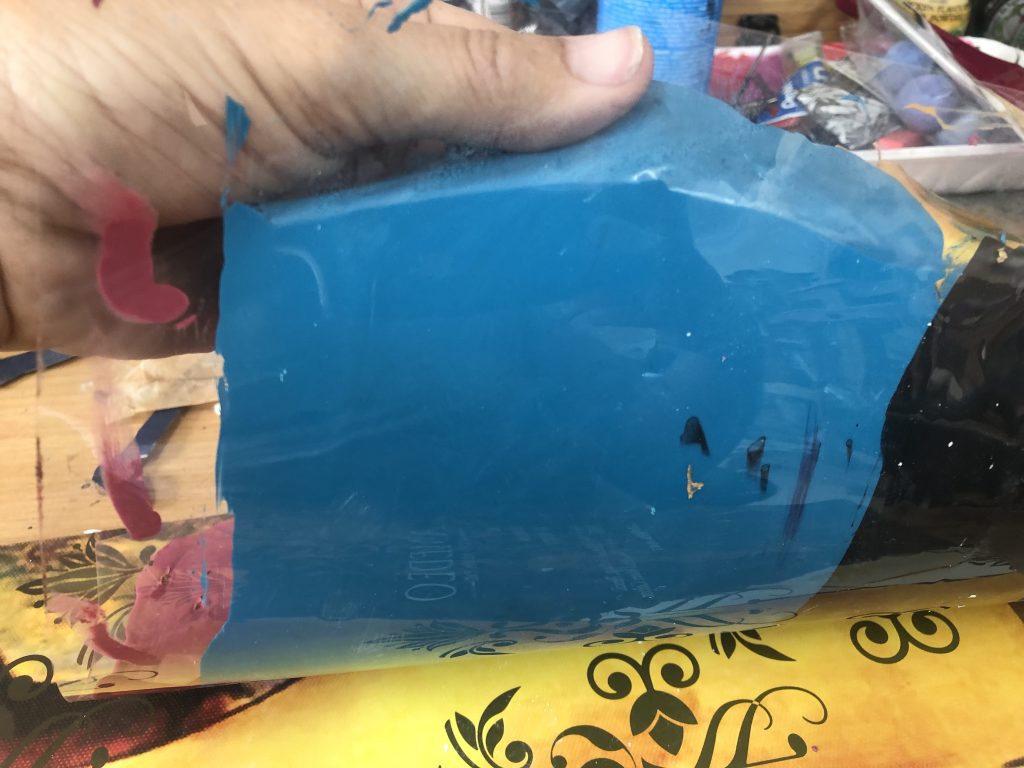
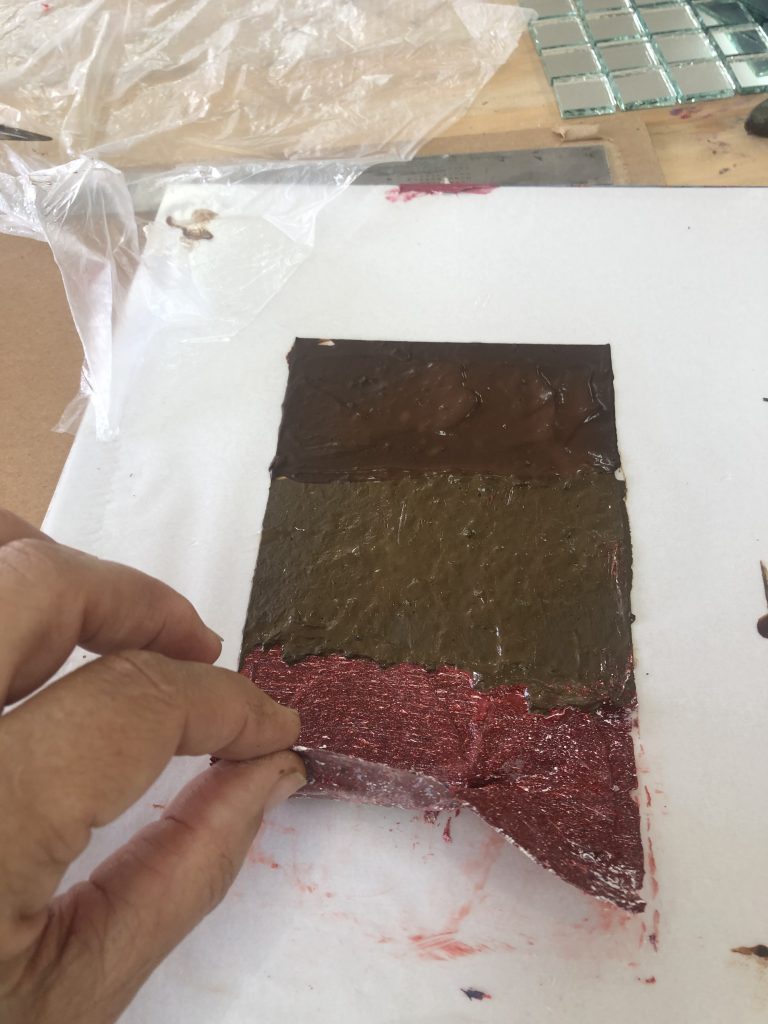


The ‘back side’, which was on the surface (is always hidden in a painting on a surface, being a canvas, a stretcher, a board) is shiny and smooth – no paintbrush strokes or textures are shown. It looks like plastic, I do like the tactility of this skin-like object I created. I took the smaller samples and cut them into 3 different almost square objects. I rolled them and tried to form a mushroom – used a heat gun on a smaller piece to make the form round and shaped like a mushroom head. I will try to paint onto this.
I decided to continue with my series of Las Meninas and made cut-out forms out of the other pieces.


As I was writing these Bennett’s theory of ‘vibrant materialism’ came to mind as she reinforces the idea that matter is ” an ability to feel the vitality of the object” be it with the reason or the body, gives the option of a political engagement with the world that avoids deadening or flattening objects or reducing nature to utility
According to Barad, agential realism is about the enactment.
I tried again, I had fluid craft paint, which is also acrylic paint. I made layers, drips of different colours, on a sheet of wax paper and on an Ikea plastic bag.


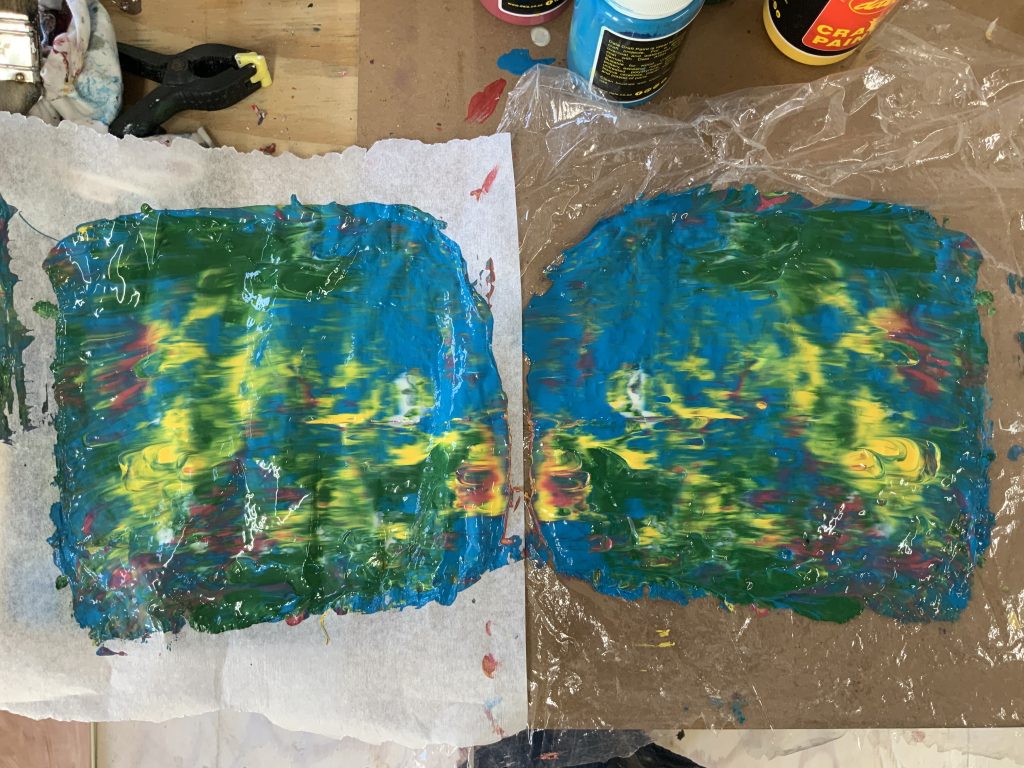
After a few minutes, I became concerned that the paint on the wax paper looked as if it might stick onto the paper and I placed a sheet of cling wrap plastic onto it. Now I had similar-looking pieces.
The paint on the wax paper dried within a day and peeled off very easily. It is not so smooth as the previous attempts – this could be due to the wax paper when the wet paint made contact with its surface. The work is more creased and not as flat as the previous works.
The next day back in the studio I worked with a scraper onto the copy on the plastic cling wrap sheet. The scraper left marks on the paint as well as adding another layer and almost seperating from the first layer, as the paint moved under the scraper. It gave the idea of giving the work a ed effect. I decided to explore that further and added more paint onto the work.

The one on the Ikea plastic was wet and I allowed for more movement in the paint by letting gravity do its work and moving and lifting the plastic support. Here the paint is thicker and it will take longer to dry. I placed it over a round form to see how it will take on the form as I see the material as soft (having plasticity) to be able to be draped over a form.


I made copies of these works in the ‘noir’ function of my phone and really liked what it created in terms of values and form.
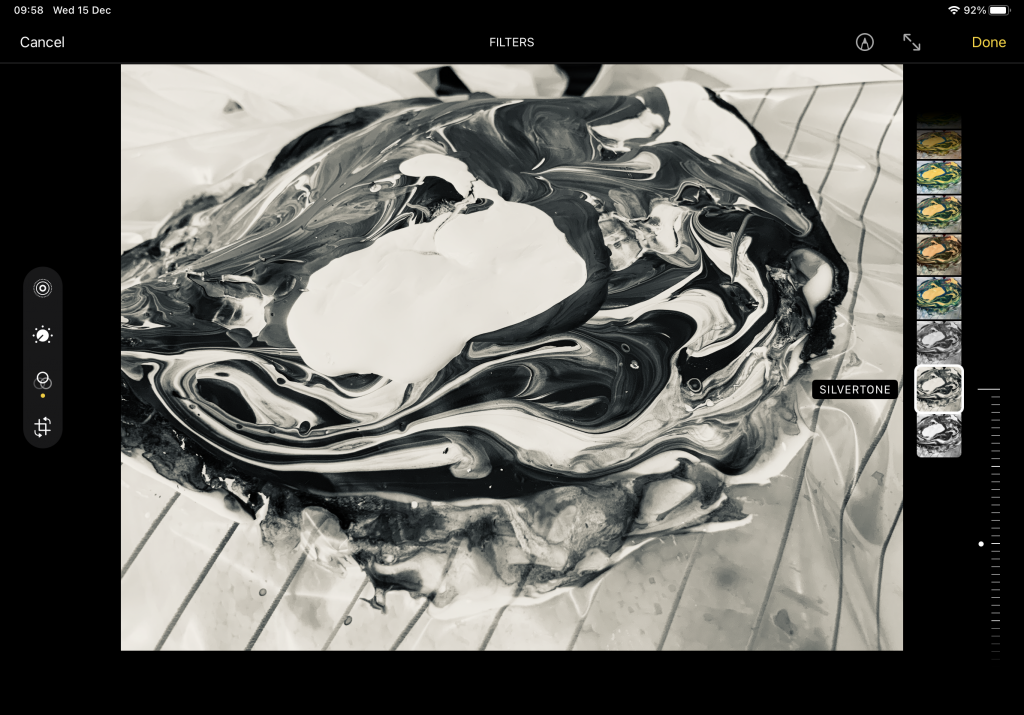



I made 3d objects from of other materials, but used paint skins moulded/manipulated to form a group of works. Here I add a ‘bowl’ made of aluminium and decorated with acrylic paint, a wire bowl, a plaster of pairs bowl, and acrylic skin ‘bowls’ to the group.

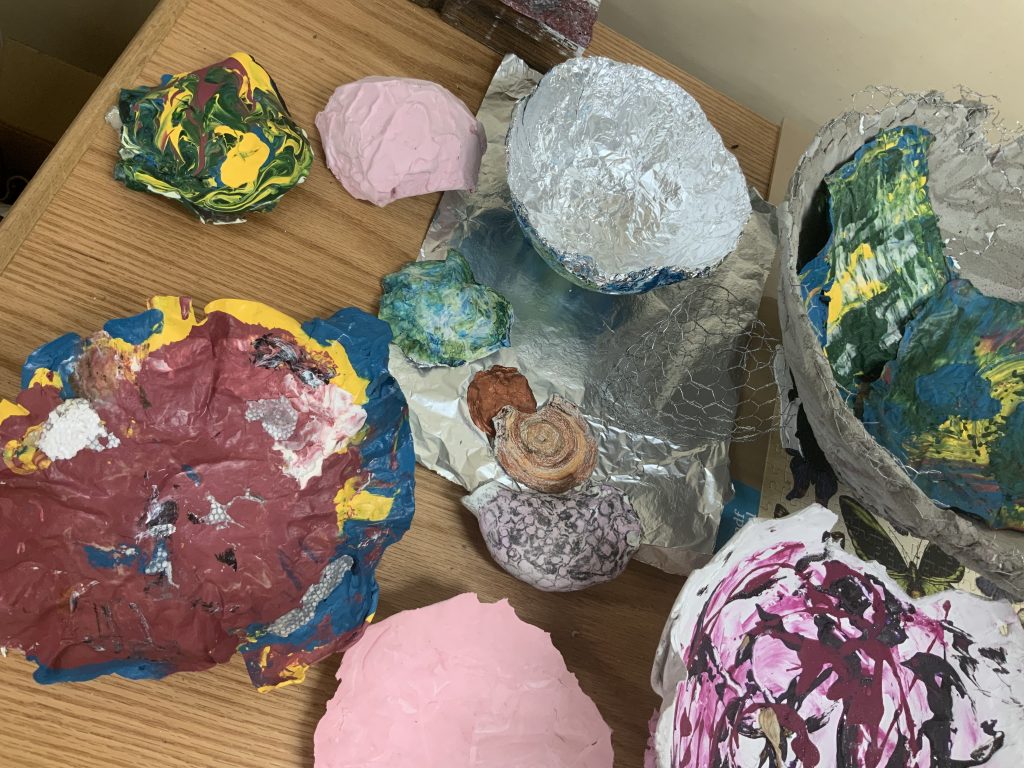

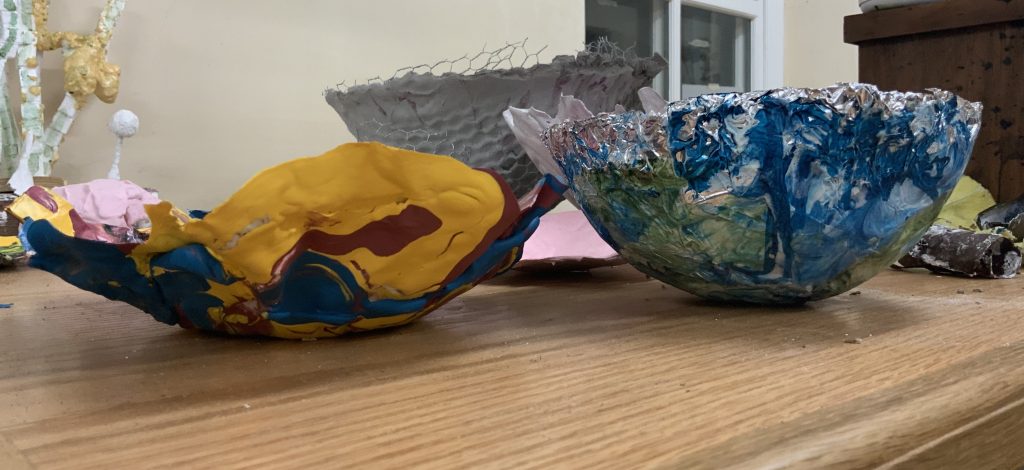
.
LIST OF ILLUSTRATIONS
Fig. 1 – Fig. 3 Stander, Karen. (2021) Acrylic paint developing as skins [Durafilm and acrylic paint] In possession of: the author: Langvlei, Riebeeck West.
Fig. 4 – Fig. 10 Stander, Karen. (2021) Acrylic skins into forms [Paint] In possession of: the author: Langvlei, Riebeeck West.
Fig 11 and Fig 12 Stander, Karen (2021) Las Meninas [Paint skins] In possession of: the author: Langvlei, Riebeeck West.
Fig 13 to Fig 17 Stander, Karen (2021) Acrylic investigations [acrylic on plastic] In possession of: the author: Langvlei, Riebeeck West.
Fig. 18 and Fig. 19 Stander, Karen (2021) Acrylic explorations [photographic studies] In possession of: the author: Langvlei, Riebeeck West.
Fig. 20 Stander, Karen (2021) Vessel explorations of paint and materials [acrylic, aluminum, clay, plaster of Paris ] In possession of: the author: Langvlei, Riebeeck West.
BIBLIOGRAPHY
Barad, K. Meeting the Universe Halfway: Quantum Physics and the Entanglement of Matter and Meaning, Durham: Duke University Press, 2007.
Best, S. Visualizing Feeling: Affect and the Feminine Avant-garde, London: I.B. Tauris, 2011.
Carter, P. Material Thinking: The Theory and Practice of Creative Research, Melbourne: Melbourne University Press, 2004.
Crouch, D. Flirting with Space: Journeys with Creativity, Burlington: Ashgate, 2010.
Dolphijn, R. and van der Tuin, I. New Materialism: Interviews and Cartographies, Ann Arbor: Open Humanities Press, 2012.
Gauntlett, D. Making is Connecting: The Social Meaning of Creativity from DIY and Knitting to YouTube and Web 2.0, Cambridge: Polity Press, 2011.
Grosz, E. Volatile Bodies, Bloomington: Indiana University Press, 1994.
Hawkins, H. For Creative Geographies: Geography, Visual Arts and the Making of Worlds, London: Routledge, 2014.
Hawkins, H. Geographical Aesthetics: Imagining Space, Staging Encounters, London: Routledge, 2015.
Hickey-Moody, A. and Page, T. Arts, Pedagogy and Cultural Resistance: New Materialism, 2016.
Ingold, T. Making: Anthropology, Archaeology, Art and Architecture, 2013.
Macleod, K. and Holdridge, L. ‘The Enactment of Thinking: The Creative Practice Ph.D’ in Journal of Visual Art Practice vol. 4 no. 2 and 3, 2005.
Preston, J. Performing Matter: Interior Surface and Feminist Actions, Baunach, Germany: Spurbuch Verlag, 2014.
Smith, J. ‘New Bachelards?: Reveries, Elements and Twenty-First Century Materialism’ in Altre Modernità (Other Modernities), Numero Speciale Bachelard e la Plasticità della Materia, 2012, pp.156-167.
Reflection
I understood the project as looking at paint’s potential to create from as well as surface. The acrylic painted layers peeled off the plastic support, reminded me of skin. It is elastic, can be translucent and flexible. Removing it from the surface I choose was not so easy, I learned that there was obviously a reason why I should use the polyurethane or acrylic sheet – as a base for the paint, it does not allow for adherence, my film made this difficult to pull the layers neatly off. I also learned that where the material was not evenly spread over the surface, the thinner areas had a tendency to break easily, too brittle. I would have also preferred to use fluid acrylic paint, which I did not have available in my studio.
Being able to try and manipulate the materials by exploring their innate materiality reminded, no, confirmed why I started painting, and need to keep it part of my studio practice: there is so much to be said with paint on a surface, so much to understand whilst working with the medium as well as so much to experience whilst working with paint, from mixing it to placing it onto the canvas. As an adult, I was motivated to paint by seeing works of artists, but mostly the impressionistsVan Gogh, Matisse, Gaugin, and later L Freud but my heart was taken with the paintings of W A Bouguereau and Monet. I understand that it is this materiality between brush, paint, and support that draws a viewer to painting – looking and admiring this medium also for the surface and sensuality it brings.
It is as if the skin (acrylic paint) is an object! Did the material become an object or does it have the abilities of an object? I wonder about the fact that one cannot see brush marks but pure dried paint. It is the truth the viewer will see, pure paint. Can I say they can now speak for themselves? Deleuze ascertained that the surface lies within the domain of effects and that depth is merely the effect of the surface. He explains that everything changes nature as it climbs to the surface. (Deleuze, 1990: 180)
I learned that as much as I want to manipulate and create, the paint is part of the making, it is actively a participant in the way I can conceptualize my ideas. It reminded me of being present in making, that process of making. I tried not to focus on a finished product, and do not want to critique the work above on that. There was much more a focus on the process as part of making a work where I build up the surface to the point that I could successfully peel it off the plastic sheet. I searched for advice in terms of the mixture and found a Youtube video that states that the paint and medium should be equal amounts. I decided to do a third painting with the correct ‘recipe’.
BIBLIOGRAPHY
Deleuze, Gilles, 1990 Logic of Sense. translated by Boundas, Lester and Stivale
We will thus consider the interface as a sort of ‘state of “being on the edge”’,2 as a scene and surface of virtuality. And yet this is not a state like stillness, interfaces an effect – the surface of the object does not ultimately separate, but rather establishes a certain space of permeability, becoming – other. It is within this permeability that we can consider the intermediate surface between the skin and the surface of the object. If it is possible to subordinate one at the expense of the other, this will be possible through the transformation of the interface, through the designing of its flow and blockades. The interface as a ‘space, in which information traverses from one entity to another, from one intersection within the system to another’ also indicates the vastness of the (re)presentation logic and the effects of the circulation and the reading of images within the art system. The issue of the reception of art thus represents the essential question of the interface as the effect of a certain constellation of knowledge and the genealogy of art – i.e.art as an institution and subject that addresses and sees the spectator as such. If human skin outlines the field of politics as a state (of relationships) on the border between objects and humans, in a slightly derivative sense (at this2‘It is that moment where one significant material is understood as distinct from another significant material. In other words, an interface is not a thing, an interface is always an effect.’ Galloway, Alexander.The Interface Effect . Cambridge:Polity Press, 2012. 31–33.